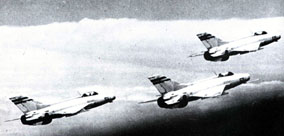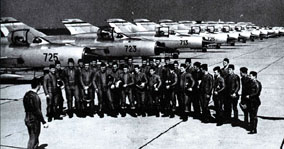| Undoubtedly the best known off all Soviet aircraft and built in
larger numbers than any other warplane since the end of World War II, the MiG-21 was one
of the most important warplane types fielded by the USSR together with its allies and
clients in the 1960s and 1970s, and is still a valuable element in the inventory of many
smaller air forces, whose continued adherence to the type is indicated by the number of
update schemes developed by Western aircraft and avionics companies in the period after
the collapse of the USSR.
Schemed as a fast-climbing
day interceptor, the MiG-21 indicates to extent to which conceptually different approaches
can be used for the same basic end, for it was radically different from the two most
important Western types planned for the same task, namely the Dassault Mirage III and
Lockheed F-104 Starfighter, and indeed was considerably more successful than either of the
Western interceptors in numerical terms.
 |
This should not be allowed
to disguise the fact, however, that the MiG-21 was in its first versions woefully
deficient in endurance, sensor capability and, to a slightly lesser extent, firepower. In
the aftermath of the Korean War (1950-1953), the Soviets undertook a careful analysis of
the performance of their warplanes in that conflict, and in March or April 1954 issued a
requirement for a day interceptor in which virtually every other factor was subordinated
to the need for outright flight performance. This was exactly the rationale that led
’Kelly’ Johnson to develop the F-104 as a heavily loaded ‘manned missile’ with a
powerful turbojet and small but straight flying surfaces, while the Soviets finally opted
for an altogether different approach reflected in a lightly loaded aerodynamic platform
with a comparatively low-powered turbojet and large but swept flying surfaces. The
aerodynamic configuration for the new type was investigated with the aid of the TsAGI
(Central Aerodynamic and Hydrodynamic Institute), which recommended a tailed configuration
based on a conventional wing swept at between 57 and 60 degrees or a delta wing swept at
between 50 and 55 degrees. |
|
Armed with these TsAGI recommendations, the
competing Mikoyan-Gurevich and Sukhoi design bureaux each developed perhaps a dozen
differing prototypes of varying configurations and sizes with higher- and lower-powered
turbojet powerplants. These were intended to validate a number of design concepts, and all
the MiG types were powered by a single engine. The most important of these was the Ye-50
of 1955, which had a swept wing based on that of the MiG-19 fighter and reached a maximum
speed of 2460 km/h or Mach 2.32 with a hybrid powerplant comprising one RD-9Ye turbojet
rated et 37.26 kN with afterburning and one S-155 rocket motor at the base of the vertical
tail surface. The Ye-50 provided much useful data for the following ‘clean paper’
designs. These were the Ye-4 and related Ye-5 with a delta wing, and the Ye-2 with a
conventional swept wing. Each of these was probably powered by the RD-9Ye engine pending
the availability of the definitive MNPK ‘Soyuz’ (Tumanskii) R-11 turbojet.The first of these MiG-21
precursors to fly was the Ye-4, which took to the air for its initial flight in December
1955. The R-11 engine became available in the spring of 1956 for the two definitive
prototypes, which were the Ye-2A and Ye-5 that first flew in May and June 1956
respectively. These prototypes took part in the great 1956 fly-by at the Aviation Day
Display at Tushino near Moscow, and received the NATO reporting names ‘Faceplate’ and
‘Fishbed’ respectively. The two aircraft were exhaustively tested, and neither
revealed a clear advantage over the other. In December 1956, the delta-winged Ye-5 was
finally selected as the basis for a production model as it had slightly greater fuel
capacity as well as greater growth potential, and there followed the Ye-6 pre-production
prototype used for development of the powerplant and flight-control system. The type was
at last cleared for production during 1958 as the MiG-21, which received the NATO
reporting name ‘Fishbed-B’.
 |
This was really a pilot
production model armed with two 30 mm Nudel’man-Rikhter NR-30 cannon and powered by the
R-11 turbojet rated at 38.25 kN dry and 50.01 kN with afterburning, and supplied with fuel
from an internal capacity of 2340 liters.
special thanks to Luka
Baturan |